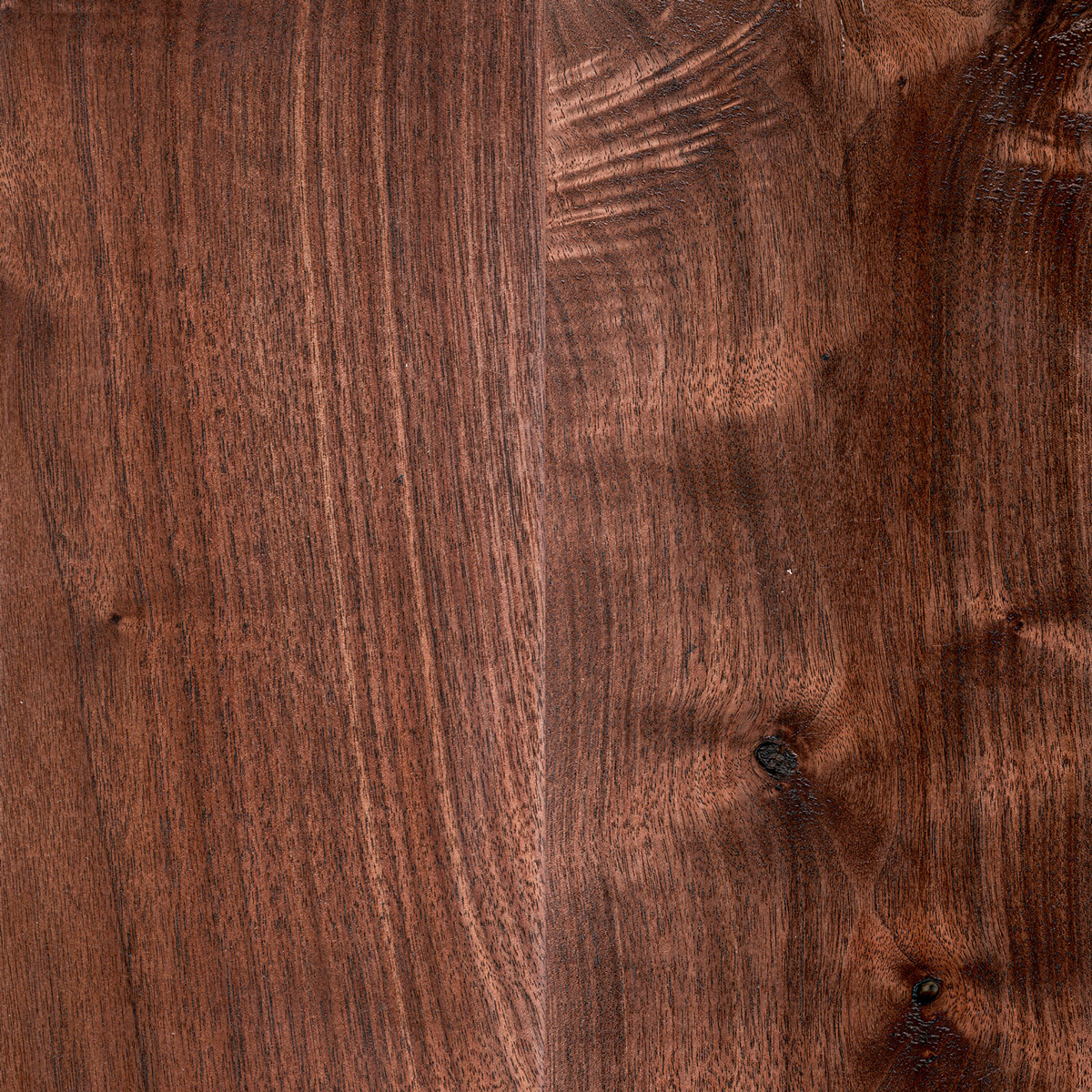American Walnut
Also known as: Black Walnut, Black Hickory
Scientific: juglans nigra
Janka Hardness: 1,010
Elastic Modulus: 11.59 GPa
One of the most highly sought out species in North America, it would be hard to overstate Black Walnut’s popularity among woodworkers in the United States. Its cooperative working characteristics, coupled with its rich brown coloration puts the wood in a class by itself among temperate-zone hardwoods. To cap it off, the wood also has good dimensional stability, shock resistance, and strength properties.
Character:
Grain is usually straight, but can be irregular. Has a medium texture and moderate natural luster. Typically easy to work provided the grain is straight and regular. Planer tearout can sometimes be a problem when surfacing pieces with irregular or figured grain. Glues, stains, and finishes well, (though walnut is rarely stained). Responds well to steam bending.
Color of American Walnut:
Heartwood can range from a lighter pale brown to a dark chocolate brown with darker brown streaks. Color can sometimes have a grey, purple, or reddish cast. Sapwood is pale yellow-gray to nearly white. Figured grain patterns such as curl, crotch, and burl are also seen.
Common uses for American Black Walnut:
- Black walnut (Juglans nigra) is a hardwood known for its rich, dark brown color and attractive grain pattern. It is valued for its durability, workability, and the distinct aesthetic qualities it brings to various applications. Some of the most common uses for black walnut include:
Furniture:
- Fine Furniture: Black walnut is highly prized in furniture making. It is used to craft high-quality pieces such as tables, chairs, dressers, and cabinets due to its beautiful color and grain characteristics.
Cabinetry:
- Kitchen Cabinets: Black walnut is often used for crafting kitchen cabinets, providing a luxurious and elegant appearance to the cabinetry.
Flooring:
- Hardwood Flooring: Black walnut flooring is popular for its rich color and durability. It adds warmth and sophistication to interior spaces.
Paneling and Millwork:
- Interior Paneling: Black walnut is used for wall paneling, wainscoting, and other interior millwork, enhancing the visual appeal of rooms.
Turnery:
- Woodturning: The workability of black walnut makes it a favorite for woodturning projects, creating items like bowls, vases, and other decorative turned pieces.
Musical Instruments:
- Guitars: Black walnut is occasionally used for crafting the bodies and backs of acoustic guitars, contributing to both the aesthetics and tonal qualities.
Gunstocks:
- Firearms: The wood's strength and attractive appearance make it suitable for crafting gunstocks, especially in high-end firearms.
Sculptures and Artistic Woodworking:
- Artistic Creations: Black walnut is chosen by artists and woodworkers for creating sculptures, carvings, and other artistic pieces due to its beautiful grain and color.
Outdoor Furniture:
- Patio Furniture: While not as weather-resistant as some other outdoor woods, black walnut is still used to craft high-end outdoor furniture where aesthetics are a priority.
Interior Joinery:
- Doors and Windows: Black walnut may be used for crafting interior doors and window frames, adding a touch of elegance to architectural elements.
Veneer and Plywood:
- Veneer: Black walnut veneer is used to enhance the appearance of plywood and other composite materials, making it a popular choice for high-end cabinetry and furniture.
Kitchenware:
- Cutting Boards and Utensils: Due to its hardness and durability, black walnut is used to craft cutting boards, utensils, and other kitchenware items.
Specialty Items:
- Box Making: Black walnut is often used for crafting high-end boxes and containers, contributing to the creation of jewelry boxes, humidors, and other specialty items.
It's important to note that black walnut is a premium hardwood, and its use in various applications is often associated with a desire for a high-quality, aesthetically pleasing finished product. The wood is also valued for its workability, allowing craftsmen to create intricate and finely detailed pieces.
Fun facts about American Walnut:
- Walnuts have a formidable shell that resembles a human head, so ancient Greeks referred to them as karyon (meaning head). Crack open that tough exterior and you’ll find a bumpy textured meat that bears a marked resemblance to the brain.
- Walnuts are among the oldest tree food known to man, being traced back to 7,000 B.C.
- Ancient civilizations made walnut milk for a sweet refreshment, and many people still enjoy walnut milk today.
- Walnuts and yogurt go together like honey and peanut butter.
- Allen Phillips once installed an 18' tall Walnut accent wall while wearing a leg brace after nearly cutting his leg off with a chainsaw.

We typically offer American Walnut in the following sizes and grades:
| Scientific | Sub-species | Grade | Features | 4/4 | 5/4 | 6/4 | 8/4 | 12/4 | Plywood | Circle Sawn | Live Edge | Beam |
|---|---|---|---|---|---|---|---|---|---|---|---|---|
| Juglans nigra | Walnut | Clear | No knots, clear grain with even color | |||||||||
| Juglans nigra | Walnut | Knotty | Some pin sized knots | |||||||||
| Juglans nigra | Walnut | Sappy | Heart and sap wood with wide ranging light and dark tones. |
Scientific information about American Walnut:
| Common Name(s) | Black Walnut; American Walnut; Black Hickory |
| Scientific Name | juglans nigra |
| Distribution | Eastern United States |
| Tree Size | 100'-120' tall, 2'-3' in diameter |
| Average Dry Weight | 3.16 lbs per bdft |
| Janka Hardness | 1,010 LBF |
Check out some species other than American Walnut
Contact us Have questions about our products?
Give us a call or shoot us an email, we can help you find the right kind of wood to make your project look fantastic! From kiln dried lumber to flooring, molding to butcher butcher block counter tops, we've got you covered.
WOOD IS UNIVERSALLY BEAUTIFUL TO MAN. IT IS THE MOST HUMANLY INTIMATE OF ALL MATERIALSFRANK LLOYD WRIGHT, AMERICAN ARCHITECT